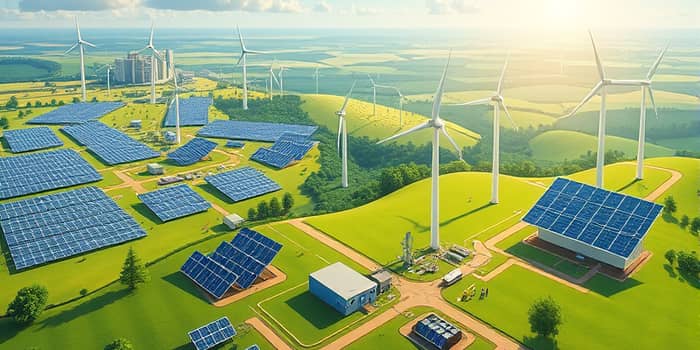The global energy landscape is undergoing a profound transformation, driven by the urgent need to address climate change, enhance energy security, and capitalize on the economic opportunities of the 21st century. As investors seek both returns and impact, renewable energy has emerged as a leading frontier. This article delves into the current market dynamics, financial flows, technological drivers, regional trends, risks, and practical steps for investors aiming to shape and benefit from this historic shift.
Current State of the Global Renewable Energy Market
In 2023, the world added a record 536 GW of renewable power capacity, pushing the share of renewables to almost 13% of total global energy consumption. This expansion reflects unprecedented capacity additions worldwide and highlights solar energy’s rapid ascent. Photovoltaic technologies are now more efficient and affordable than ever, driving solar to potentially supply nearly half of all new electricity demand by 2025.
Offshore wind is also gaining momentum, diversifying portfolios beyond traditional onshore installations. In key markets like the U.S., policy commitments aim to propel solar ahead of coal as a principal generation source. Worldwide, renewables are on track to represent 90% of electricity consumption growth through 2025, underscoring a fundamental shift toward cleaner power.
Investment Landscape and Financial Flows
Investment in renewable energy has surged from $348 billion in 2020 to $499 billion in 2022, marking a 16% year-on-year increase. In 2023 alone, solar and wind technologies attracted $200 billion, a 75% boost over the previous year. Clean energy now commands $1.9 trillion of the $3 trillion annual global energy investment, though reaching net-zero goals by 2035 will require $5.3 trillion per year.
Declining installation costs—69% for solar PV, 33% for onshore wind, and 45% for offshore wind since 2013—have fueled dramatic cost declines across technologies, enhancing returns and widening adoption. Despite this, investment in hydropower, biomass, biofuels, geothermal, and marine energy dropped by 45% from 2017 to 2022, presenting both challenges and niche opportunities.
Key Drivers: Policy, Technology, and Corporate Demand
Government incentives remain a cornerstone of growth. Feed-in tariffs in China and Vietnam, tax credits in the U.S., and auction schemes in Europe have spurred deployment. At the same time, corporate power purchase agreements (PPAs) are gaining traction as tech giants seek robust policy incentives and market signals to power data centers and AI operations with carbon-free electricity.
- Expanding data centers could double electricity demand to 860 TWh by 2030.
- Electric vehicle (EV) adoption adds significant load, pushing batteries to the forefront.
- Domestic cleantech manufacturing and reshoring drive 11 GW of new demand by 2030.
- Carbon monetization and operational AI offer fresh competitive advantages.
These catalysts combine to create diversifying energy portfolios beyond solar and wind, reflecting a holistic approach to the energy transition.
Risks, Barriers, and Market Uncertainty
Despite clear momentum, renewables face headwinds. Permitting delays and grid bottlenecks can stall projects for years, while fossil fuel subsidies—amounting to $5.9 trillion globally in 2022—distort competition. Policy shifts and geopolitical tensions inject volatility, and higher interest rates have pressured green energy stocks.
- Regulatory and permitting delays disrupt timelines.
- Grid integration challenges limit capacity absorption.
- Subsidized fossil fuels skew market economics.
- Policy uncertainty undermines investor confidence.
Navigating these barriers requires strategic foresight and stakeholder engagement to reduce execution risk and secure stable returns.
Regional Leaders and Laggards
China remains the powerhouse of renewable deployment, accounting for over 50% of global additions in 2023. The European Union follows closely, leveraging mature carbon markets and the Carbon Border Adjustment Mechanism (CBAM) to drive demand. In the U.S., bipartisan infrastructure support and state-level mandates underpin rapid growth, especially in solar and storage.
Conversely, many emerging economies face financing constraints, inadequate grid infrastructure, and policy fragmentation. India and Brazil display pockets of strength in solar and wind, but investment flows remain uneven. Bridging this gap represents both a development imperative and a potential source of alpha for forward-looking investors.
Future Projections and Strategic Opportunities
Forecasts to 2030 suggest renewables will satisfy the bulk of new electricity demand, with storage emerging as a pivotal enabler. Energy storage capacity additions are poised for a breakout year in 2025, mitigating intermittency and capturing surplus supply during low-demand periods. Meanwhile, emerging technologies—green hydrogen and carbon capture—offer transformative potential when paired with existing assets.
To thrive in this evolving landscape, investors should seek long-term economic resilience and environmental gains by aligning portfolios with technologies at different maturity stages. Early engagement in nascent markets and robust evaluation of supply chain security and grid integration will differentiate winners from laggards.
- Diversify across solar, wind, and storage assets.
- Invest in grid modernization and digital energy platforms.
- Support innovation in hydrogen and CCUS.
- Advocate for stable, transparent policy frameworks.
Practical Guidance for Investors
Investors entering the renewable energy market can enhance success by following a structured approach. Begin with rigorous due diligence on technology performance, policy stability, and developer track records. Establish strategic partnerships with experienced developers to mitigate execution risks and accelerate project timelines.
Next, build diversified portfolios that balance mature technologies—such as utility-scale solar and onshore wind—with emerging opportunities in storage, offshore wind, and green hydrogen. Engage early with regulators, communities, and offtakers to streamline permitting and secure favorable PPAs.
Finally, adopt a forward-looking lens: monitor global decarbonization commitments, track cost curves, and stay informed on embracing emerging technologies like green hydrogen and digital energy management. By doing so, investors can drive long-term economic resilience and environmental gains while participating in a market poised for exponential growth.
In a rapidly shifting energy paradigm, renewable investments offer a rare convergence of financial returns and societal impact. By blending strategic foresight, operational excellence, and deep stakeholder engagement, investors can play a pivotal role in powering a sustainable future.
References
- https://www2.deloitte.com/us/en/insights/industry/renewable-energy/renewable-energy-industry-outlook.html
- https://www.iea.org/reports/global-energy-review-2025
- https://www.energy.gov/eere/look-ahead-clean-energy-2025
- https://about.bnef.com/new-energy-outlook/
- https://diversegy.com/renewable-energy-trends-2025/
- https://en.wikipedia.org/wiki/Renewable_energy
- https://www.rystadenergy.com/news/energy-2025-trends-forecast
- https://www.ren21.net/why-is-renewable-energy-important/










